Leadership and Organizational Behavior Analysis: XYZ Company Case
VerifiedAdded on 2022/12/05
|13
|3681
|396
Case Study
AI Summary
This case study analyzes XYZ Training Consultants, a Malaysia-based company, focusing on the leadership transition from the founder, Tim Redkin, to his daughter, Fiona. The paper examines the shift in organizational behavior, highlighting the contrast between Tim's open management style and Fiona's more structured, hierarchical approach. It explores the impact of these changes on employee motivation, organizational justice, and staff turnover. The study delves into motivational elements, comparing employee engagement during both leadership tenures. It analyzes the behavior of training consultants using organizational justice and equity theory. The study concludes with recommendations for Fiona to overcome challenges, incorporating appraisal systems and promoting fairness and equality to improve the work environment and address issues that led to significant employee attrition.
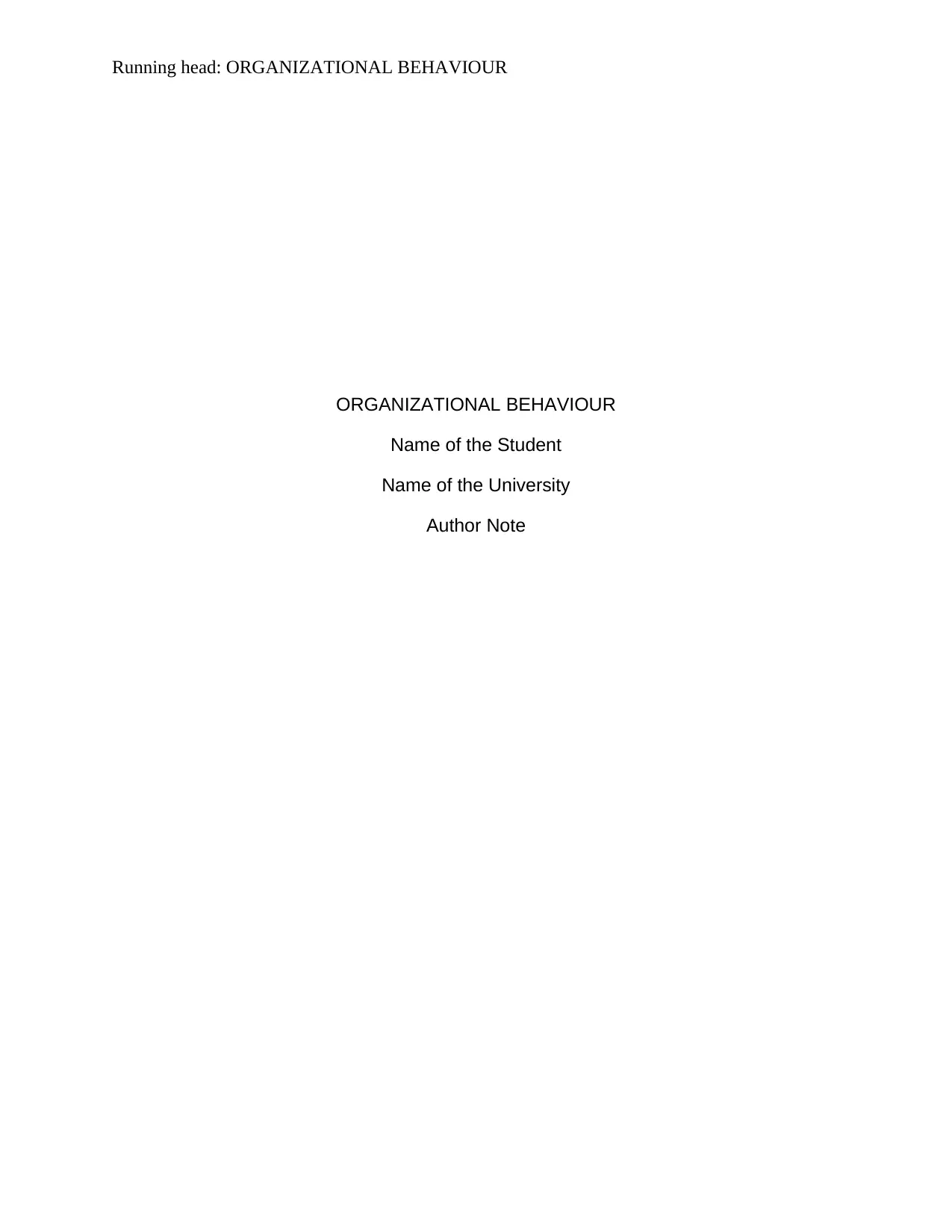
Running head: ORGANIZATIONAL BEHAVIOUR
ORGANIZATIONAL BEHAVIOUR
Name of the Student
Name of the University
Author Note
ORGANIZATIONAL BEHAVIOUR
Name of the Student
Name of the University
Author Note
Paraphrase This Document
Need a fresh take? Get an instant paraphrase of this document with our AI Paraphraser
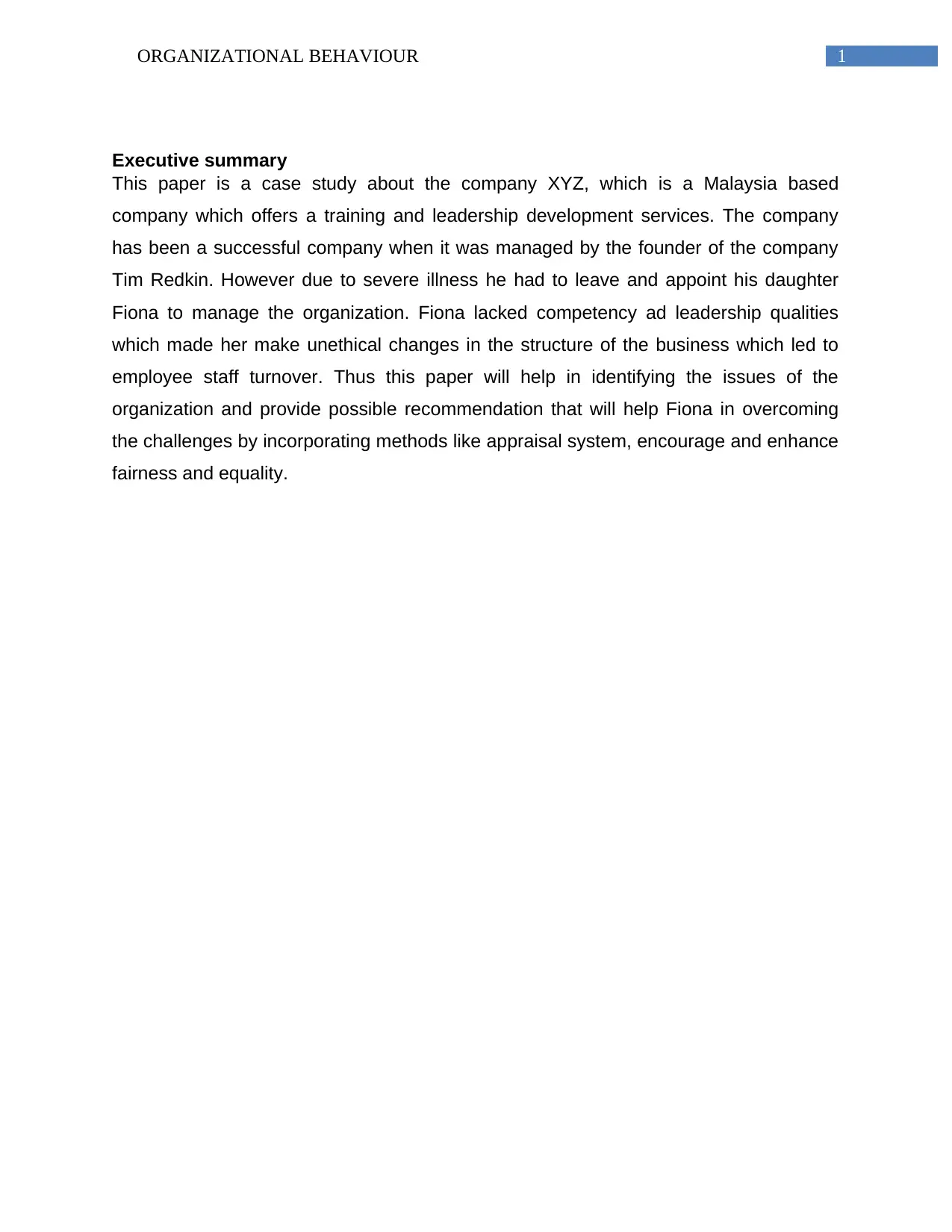
1ORGANIZATIONAL BEHAVIOUR
Executive summary
This paper is a case study about the company XYZ, which is a Malaysia based
company which offers a training and leadership development services. The company
has been a successful company when it was managed by the founder of the company
Tim Redkin. However due to severe illness he had to leave and appoint his daughter
Fiona to manage the organization. Fiona lacked competency ad leadership qualities
which made her make unethical changes in the structure of the business which led to
employee staff turnover. Thus this paper will help in identifying the issues of the
organization and provide possible recommendation that will help Fiona in overcoming
the challenges by incorporating methods like appraisal system, encourage and enhance
fairness and equality.
Executive summary
This paper is a case study about the company XYZ, which is a Malaysia based
company which offers a training and leadership development services. The company
has been a successful company when it was managed by the founder of the company
Tim Redkin. However due to severe illness he had to leave and appoint his daughter
Fiona to manage the organization. Fiona lacked competency ad leadership qualities
which made her make unethical changes in the structure of the business which led to
employee staff turnover. Thus this paper will help in identifying the issues of the
organization and provide possible recommendation that will help Fiona in overcoming
the challenges by incorporating methods like appraisal system, encourage and enhance
fairness and equality.
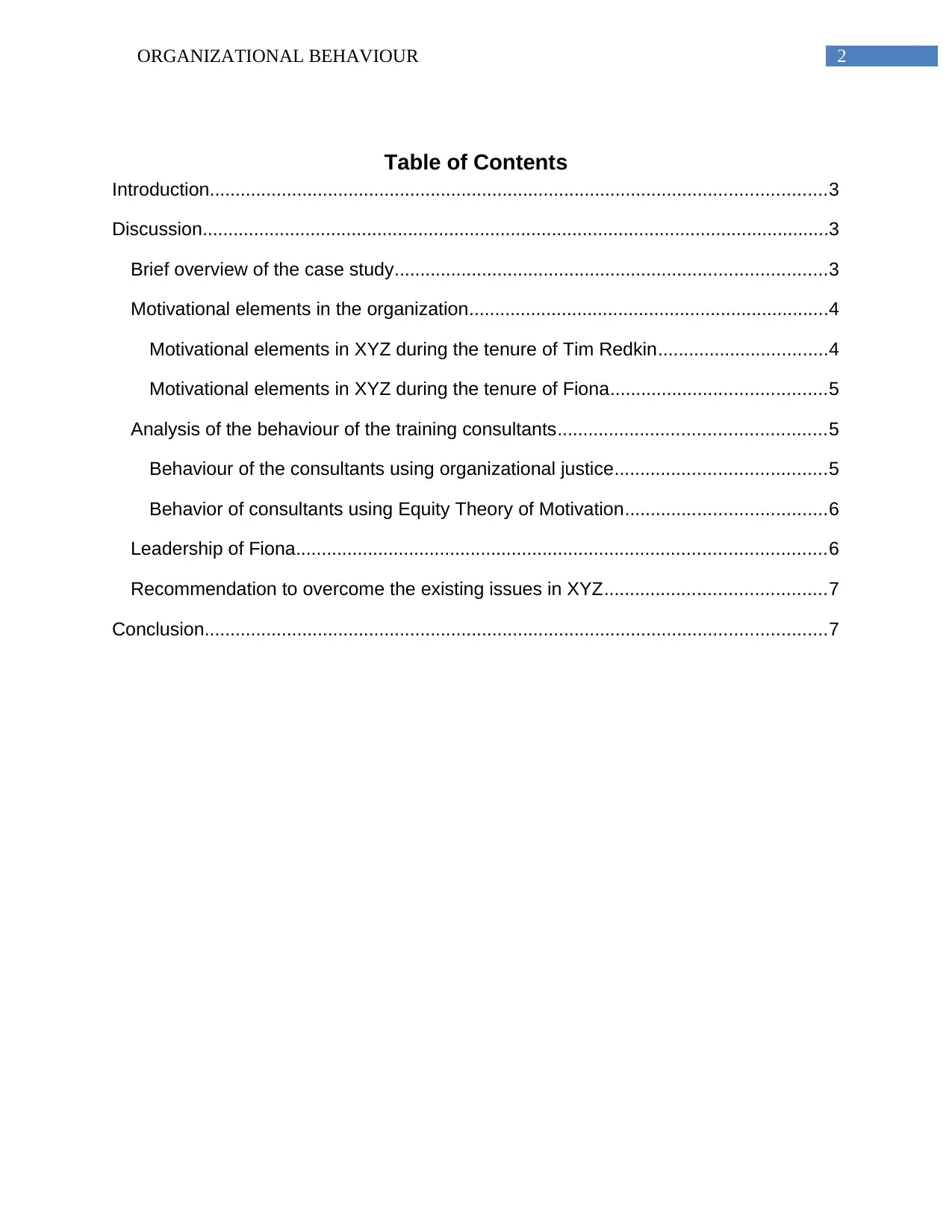
2ORGANIZATIONAL BEHAVIOUR
Table of Contents
Introduction........................................................................................................................3
Discussion..........................................................................................................................3
Brief overview of the case study....................................................................................3
Motivational elements in the organization......................................................................4
Motivational elements in XYZ during the tenure of Tim Redkin.................................4
Motivational elements in XYZ during the tenure of Fiona..........................................5
Analysis of the behaviour of the training consultants....................................................5
Behaviour of the consultants using organizational justice.........................................5
Behavior of consultants using Equity Theory of Motivation.......................................6
Leadership of Fiona.......................................................................................................6
Recommendation to overcome the existing issues in XYZ...........................................7
Conclusion.........................................................................................................................7
Table of Contents
Introduction........................................................................................................................3
Discussion..........................................................................................................................3
Brief overview of the case study....................................................................................3
Motivational elements in the organization......................................................................4
Motivational elements in XYZ during the tenure of Tim Redkin.................................4
Motivational elements in XYZ during the tenure of Fiona..........................................5
Analysis of the behaviour of the training consultants....................................................5
Behaviour of the consultants using organizational justice.........................................5
Behavior of consultants using Equity Theory of Motivation.......................................6
Leadership of Fiona.......................................................................................................6
Recommendation to overcome the existing issues in XYZ...........................................7
Conclusion.........................................................................................................................7
⊘ This is a preview!⊘
Do you want full access?
Subscribe today to unlock all pages.

Trusted by 1+ million students worldwide
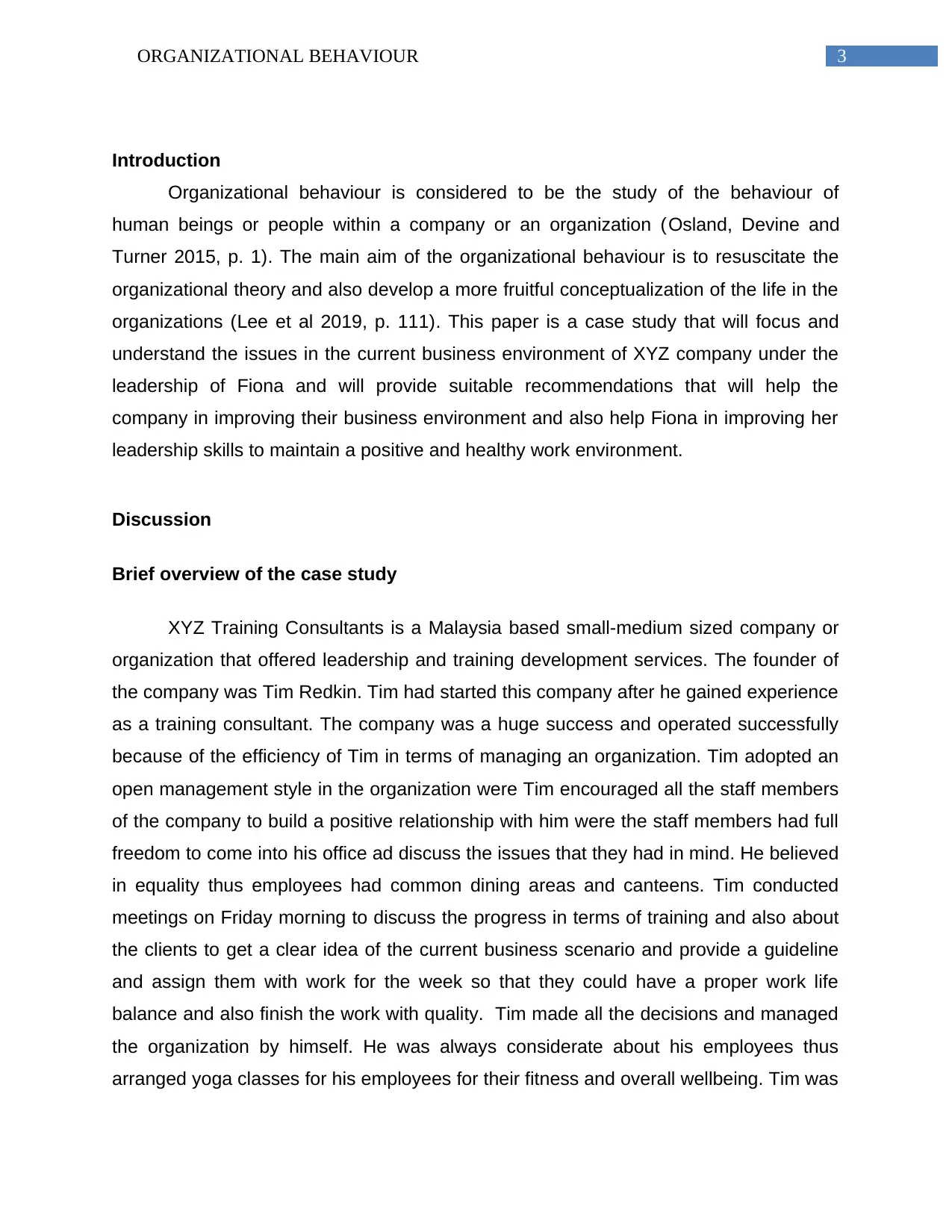
3ORGANIZATIONAL BEHAVIOUR
Introduction
Organizational behaviour is considered to be the study of the behaviour of
human beings or people within a company or an organization (Osland, Devine and
Turner 2015, p. 1). The main aim of the organizational behaviour is to resuscitate the
organizational theory and also develop a more fruitful conceptualization of the life in the
organizations (Lee et al 2019, p. 111). This paper is a case study that will focus and
understand the issues in the current business environment of XYZ company under the
leadership of Fiona and will provide suitable recommendations that will help the
company in improving their business environment and also help Fiona in improving her
leadership skills to maintain a positive and healthy work environment.
Discussion
Brief overview of the case study
XYZ Training Consultants is a Malaysia based small-medium sized company or
organization that offered leadership and training development services. The founder of
the company was Tim Redkin. Tim had started this company after he gained experience
as a training consultant. The company was a huge success and operated successfully
because of the efficiency of Tim in terms of managing an organization. Tim adopted an
open management style in the organization were Tim encouraged all the staff members
of the company to build a positive relationship with him were the staff members had full
freedom to come into his office ad discuss the issues that they had in mind. He believed
in equality thus employees had common dining areas and canteens. Tim conducted
meetings on Friday morning to discuss the progress in terms of training and also about
the clients to get a clear idea of the current business scenario and provide a guideline
and assign them with work for the week so that they could have a proper work life
balance and also finish the work with quality. Tim made all the decisions and managed
the organization by himself. He was always considerate about his employees thus
arranged yoga classes for his employees for their fitness and overall wellbeing. Tim was
Introduction
Organizational behaviour is considered to be the study of the behaviour of
human beings or people within a company or an organization (Osland, Devine and
Turner 2015, p. 1). The main aim of the organizational behaviour is to resuscitate the
organizational theory and also develop a more fruitful conceptualization of the life in the
organizations (Lee et al 2019, p. 111). This paper is a case study that will focus and
understand the issues in the current business environment of XYZ company under the
leadership of Fiona and will provide suitable recommendations that will help the
company in improving their business environment and also help Fiona in improving her
leadership skills to maintain a positive and healthy work environment.
Discussion
Brief overview of the case study
XYZ Training Consultants is a Malaysia based small-medium sized company or
organization that offered leadership and training development services. The founder of
the company was Tim Redkin. Tim had started this company after he gained experience
as a training consultant. The company was a huge success and operated successfully
because of the efficiency of Tim in terms of managing an organization. Tim adopted an
open management style in the organization were Tim encouraged all the staff members
of the company to build a positive relationship with him were the staff members had full
freedom to come into his office ad discuss the issues that they had in mind. He believed
in equality thus employees had common dining areas and canteens. Tim conducted
meetings on Friday morning to discuss the progress in terms of training and also about
the clients to get a clear idea of the current business scenario and provide a guideline
and assign them with work for the week so that they could have a proper work life
balance and also finish the work with quality. Tim made all the decisions and managed
the organization by himself. He was always considerate about his employees thus
arranged yoga classes for his employees for their fitness and overall wellbeing. Tim was
Paraphrase This Document
Need a fresh take? Get an instant paraphrase of this document with our AI Paraphraser
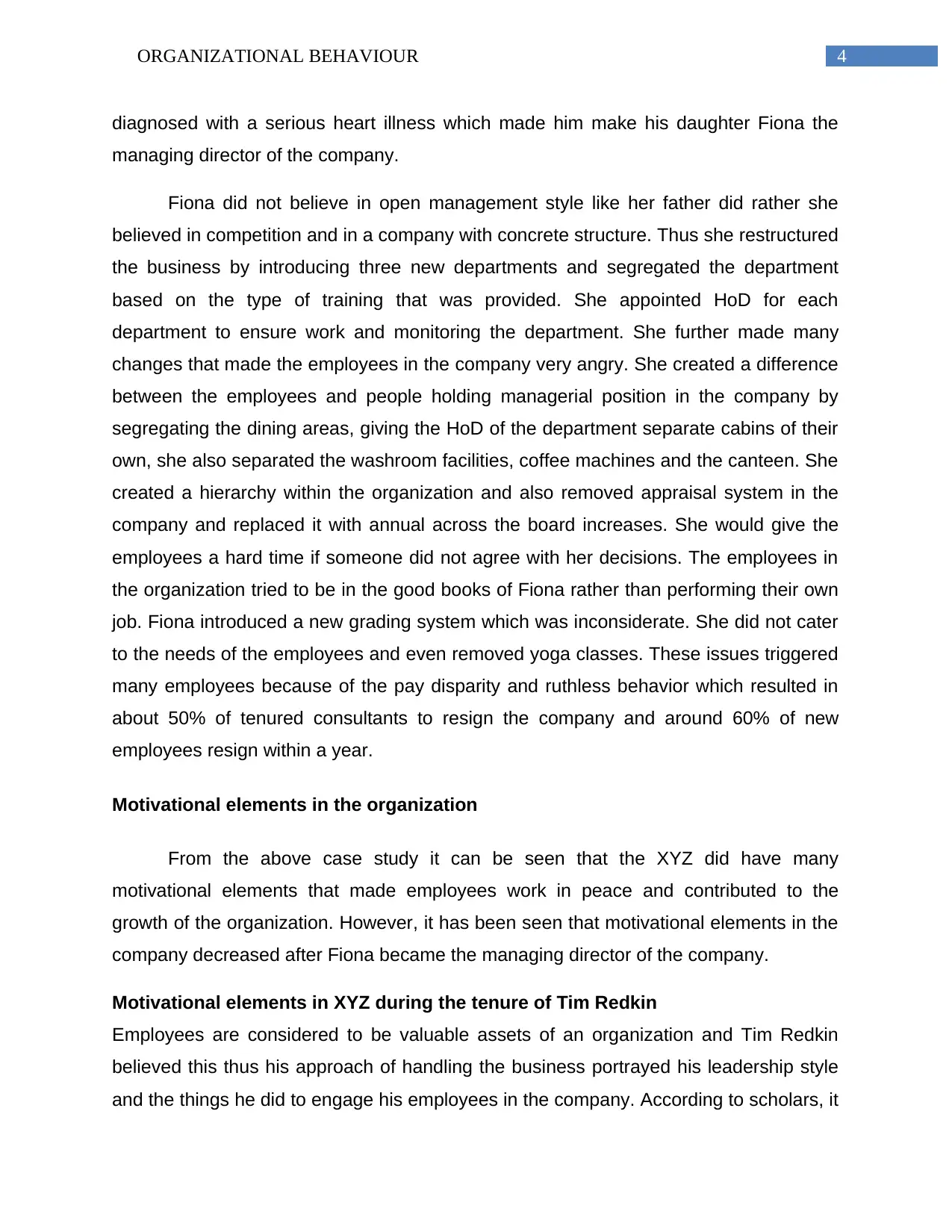
4ORGANIZATIONAL BEHAVIOUR
diagnosed with a serious heart illness which made him make his daughter Fiona the
managing director of the company.
Fiona did not believe in open management style like her father did rather she
believed in competition and in a company with concrete structure. Thus she restructured
the business by introducing three new departments and segregated the department
based on the type of training that was provided. She appointed HoD for each
department to ensure work and monitoring the department. She further made many
changes that made the employees in the company very angry. She created a difference
between the employees and people holding managerial position in the company by
segregating the dining areas, giving the HoD of the department separate cabins of their
own, she also separated the washroom facilities, coffee machines and the canteen. She
created a hierarchy within the organization and also removed appraisal system in the
company and replaced it with annual across the board increases. She would give the
employees a hard time if someone did not agree with her decisions. The employees in
the organization tried to be in the good books of Fiona rather than performing their own
job. Fiona introduced a new grading system which was inconsiderate. She did not cater
to the needs of the employees and even removed yoga classes. These issues triggered
many employees because of the pay disparity and ruthless behavior which resulted in
about 50% of tenured consultants to resign the company and around 60% of new
employees resign within a year.
Motivational elements in the organization
From the above case study it can be seen that the XYZ did have many
motivational elements that made employees work in peace and contributed to the
growth of the organization. However, it has been seen that motivational elements in the
company decreased after Fiona became the managing director of the company.
Motivational elements in XYZ during the tenure of Tim Redkin
Employees are considered to be valuable assets of an organization and Tim Redkin
believed this thus his approach of handling the business portrayed his leadership style
and the things he did to engage his employees in the company. According to scholars, it
diagnosed with a serious heart illness which made him make his daughter Fiona the
managing director of the company.
Fiona did not believe in open management style like her father did rather she
believed in competition and in a company with concrete structure. Thus she restructured
the business by introducing three new departments and segregated the department
based on the type of training that was provided. She appointed HoD for each
department to ensure work and monitoring the department. She further made many
changes that made the employees in the company very angry. She created a difference
between the employees and people holding managerial position in the company by
segregating the dining areas, giving the HoD of the department separate cabins of their
own, she also separated the washroom facilities, coffee machines and the canteen. She
created a hierarchy within the organization and also removed appraisal system in the
company and replaced it with annual across the board increases. She would give the
employees a hard time if someone did not agree with her decisions. The employees in
the organization tried to be in the good books of Fiona rather than performing their own
job. Fiona introduced a new grading system which was inconsiderate. She did not cater
to the needs of the employees and even removed yoga classes. These issues triggered
many employees because of the pay disparity and ruthless behavior which resulted in
about 50% of tenured consultants to resign the company and around 60% of new
employees resign within a year.
Motivational elements in the organization
From the above case study it can be seen that the XYZ did have many
motivational elements that made employees work in peace and contributed to the
growth of the organization. However, it has been seen that motivational elements in the
company decreased after Fiona became the managing director of the company.
Motivational elements in XYZ during the tenure of Tim Redkin
Employees are considered to be valuable assets of an organization and Tim Redkin
believed this thus his approach of handling the business portrayed his leadership style
and the things he did to engage his employees in the company. According to scholars, it
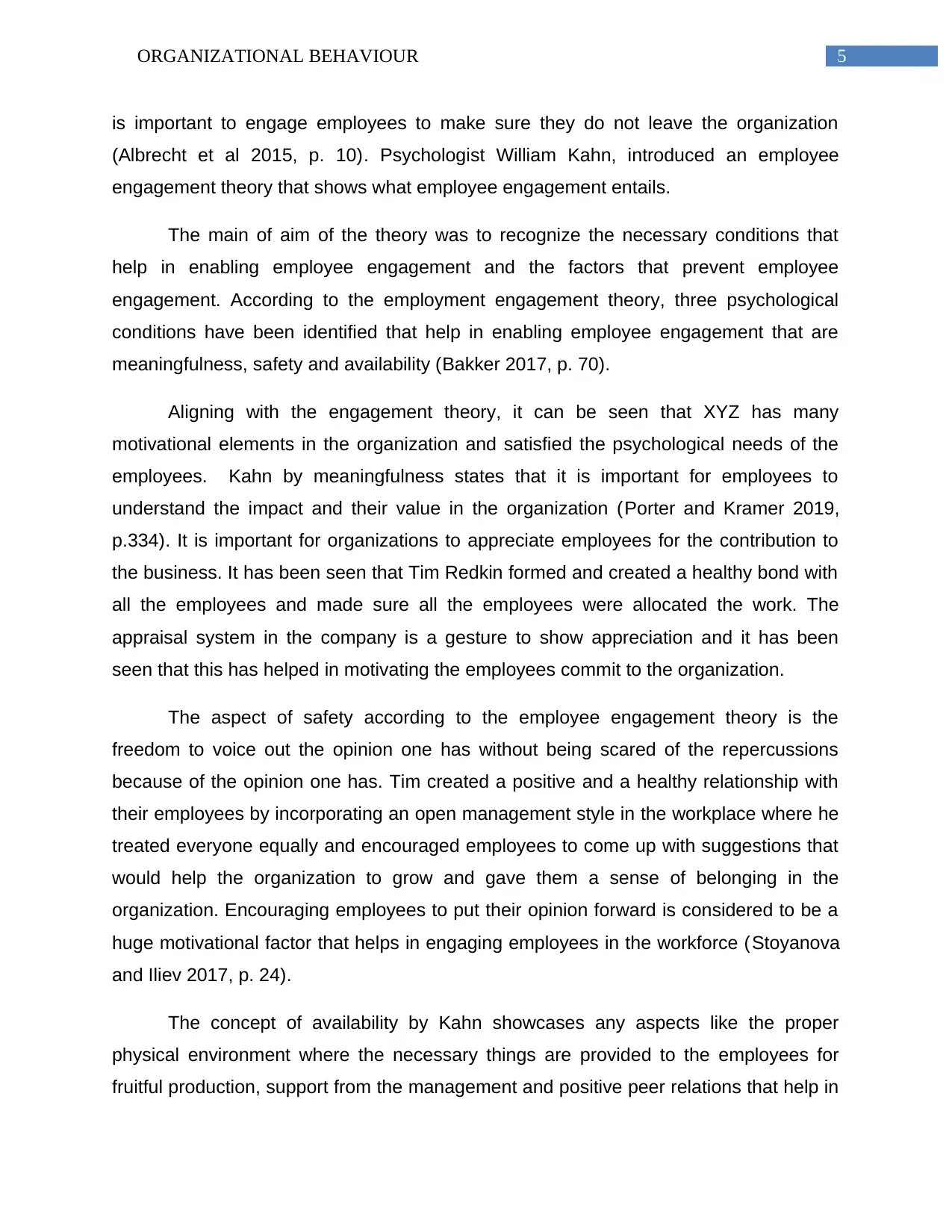
5ORGANIZATIONAL BEHAVIOUR
is important to engage employees to make sure they do not leave the organization
(Albrecht et al 2015, p. 10). Psychologist William Kahn, introduced an employee
engagement theory that shows what employee engagement entails.
The main of aim of the theory was to recognize the necessary conditions that
help in enabling employee engagement and the factors that prevent employee
engagement. According to the employment engagement theory, three psychological
conditions have been identified that help in enabling employee engagement that are
meaningfulness, safety and availability (Bakker 2017, p. 70).
Aligning with the engagement theory, it can be seen that XYZ has many
motivational elements in the organization and satisfied the psychological needs of the
employees. Kahn by meaningfulness states that it is important for employees to
understand the impact and their value in the organization (Porter and Kramer 2019,
p.334). It is important for organizations to appreciate employees for the contribution to
the business. It has been seen that Tim Redkin formed and created a healthy bond with
all the employees and made sure all the employees were allocated the work. The
appraisal system in the company is a gesture to show appreciation and it has been
seen that this has helped in motivating the employees commit to the organization.
The aspect of safety according to the employee engagement theory is the
freedom to voice out the opinion one has without being scared of the repercussions
because of the opinion one has. Tim created a positive and a healthy relationship with
their employees by incorporating an open management style in the workplace where he
treated everyone equally and encouraged employees to come up with suggestions that
would help the organization to grow and gave them a sense of belonging in the
organization. Encouraging employees to put their opinion forward is considered to be a
huge motivational factor that helps in engaging employees in the workforce (Stoyanova
and Iliev 2017, p. 24).
The concept of availability by Kahn showcases any aspects like the proper
physical environment where the necessary things are provided to the employees for
fruitful production, support from the management and positive peer relations that help in
is important to engage employees to make sure they do not leave the organization
(Albrecht et al 2015, p. 10). Psychologist William Kahn, introduced an employee
engagement theory that shows what employee engagement entails.
The main of aim of the theory was to recognize the necessary conditions that
help in enabling employee engagement and the factors that prevent employee
engagement. According to the employment engagement theory, three psychological
conditions have been identified that help in enabling employee engagement that are
meaningfulness, safety and availability (Bakker 2017, p. 70).
Aligning with the engagement theory, it can be seen that XYZ has many
motivational elements in the organization and satisfied the psychological needs of the
employees. Kahn by meaningfulness states that it is important for employees to
understand the impact and their value in the organization (Porter and Kramer 2019,
p.334). It is important for organizations to appreciate employees for the contribution to
the business. It has been seen that Tim Redkin formed and created a healthy bond with
all the employees and made sure all the employees were allocated the work. The
appraisal system in the company is a gesture to show appreciation and it has been
seen that this has helped in motivating the employees commit to the organization.
The aspect of safety according to the employee engagement theory is the
freedom to voice out the opinion one has without being scared of the repercussions
because of the opinion one has. Tim created a positive and a healthy relationship with
their employees by incorporating an open management style in the workplace where he
treated everyone equally and encouraged employees to come up with suggestions that
would help the organization to grow and gave them a sense of belonging in the
organization. Encouraging employees to put their opinion forward is considered to be a
huge motivational factor that helps in engaging employees in the workforce (Stoyanova
and Iliev 2017, p. 24).
The concept of availability by Kahn showcases any aspects like the proper
physical environment where the necessary things are provided to the employees for
fruitful production, support from the management and positive peer relations that help in
⊘ This is a preview!⊘
Do you want full access?
Subscribe today to unlock all pages.

Trusted by 1+ million students worldwide
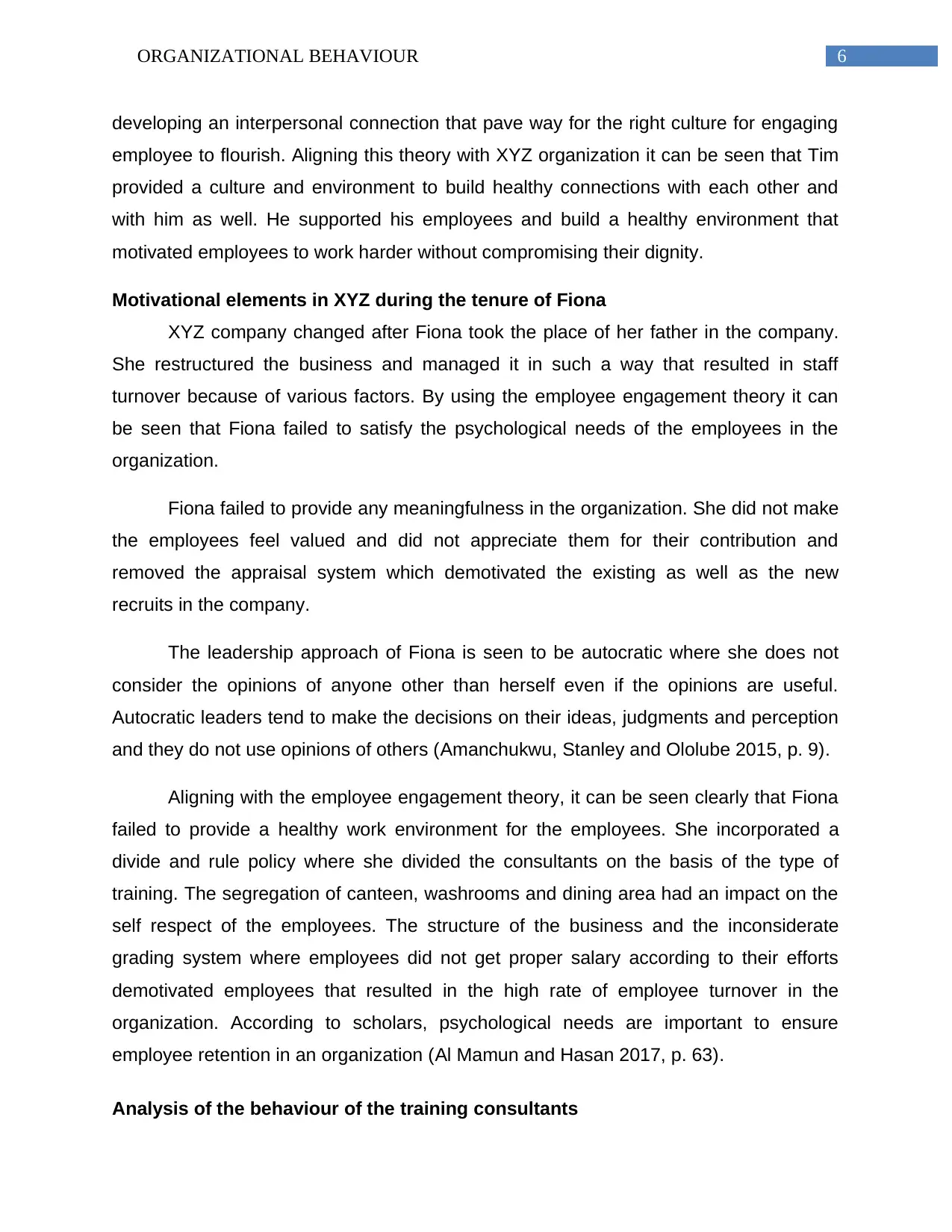
6ORGANIZATIONAL BEHAVIOUR
developing an interpersonal connection that pave way for the right culture for engaging
employee to flourish. Aligning this theory with XYZ organization it can be seen that Tim
provided a culture and environment to build healthy connections with each other and
with him as well. He supported his employees and build a healthy environment that
motivated employees to work harder without compromising their dignity.
Motivational elements in XYZ during the tenure of Fiona
XYZ company changed after Fiona took the place of her father in the company.
She restructured the business and managed it in such a way that resulted in staff
turnover because of various factors. By using the employee engagement theory it can
be seen that Fiona failed to satisfy the psychological needs of the employees in the
organization.
Fiona failed to provide any meaningfulness in the organization. She did not make
the employees feel valued and did not appreciate them for their contribution and
removed the appraisal system which demotivated the existing as well as the new
recruits in the company.
The leadership approach of Fiona is seen to be autocratic where she does not
consider the opinions of anyone other than herself even if the opinions are useful.
Autocratic leaders tend to make the decisions on their ideas, judgments and perception
and they do not use opinions of others (Amanchukwu, Stanley and Ololube 2015, p. 9).
Aligning with the employee engagement theory, it can be seen clearly that Fiona
failed to provide a healthy work environment for the employees. She incorporated a
divide and rule policy where she divided the consultants on the basis of the type of
training. The segregation of canteen, washrooms and dining area had an impact on the
self respect of the employees. The structure of the business and the inconsiderate
grading system where employees did not get proper salary according to their efforts
demotivated employees that resulted in the high rate of employee turnover in the
organization. According to scholars, psychological needs are important to ensure
employee retention in an organization (Al Mamun and Hasan 2017, p. 63).
Analysis of the behaviour of the training consultants
developing an interpersonal connection that pave way for the right culture for engaging
employee to flourish. Aligning this theory with XYZ organization it can be seen that Tim
provided a culture and environment to build healthy connections with each other and
with him as well. He supported his employees and build a healthy environment that
motivated employees to work harder without compromising their dignity.
Motivational elements in XYZ during the tenure of Fiona
XYZ company changed after Fiona took the place of her father in the company.
She restructured the business and managed it in such a way that resulted in staff
turnover because of various factors. By using the employee engagement theory it can
be seen that Fiona failed to satisfy the psychological needs of the employees in the
organization.
Fiona failed to provide any meaningfulness in the organization. She did not make
the employees feel valued and did not appreciate them for their contribution and
removed the appraisal system which demotivated the existing as well as the new
recruits in the company.
The leadership approach of Fiona is seen to be autocratic where she does not
consider the opinions of anyone other than herself even if the opinions are useful.
Autocratic leaders tend to make the decisions on their ideas, judgments and perception
and they do not use opinions of others (Amanchukwu, Stanley and Ololube 2015, p. 9).
Aligning with the employee engagement theory, it can be seen clearly that Fiona
failed to provide a healthy work environment for the employees. She incorporated a
divide and rule policy where she divided the consultants on the basis of the type of
training. The segregation of canteen, washrooms and dining area had an impact on the
self respect of the employees. The structure of the business and the inconsiderate
grading system where employees did not get proper salary according to their efforts
demotivated employees that resulted in the high rate of employee turnover in the
organization. According to scholars, psychological needs are important to ensure
employee retention in an organization (Al Mamun and Hasan 2017, p. 63).
Analysis of the behaviour of the training consultants
Paraphrase This Document
Need a fresh take? Get an instant paraphrase of this document with our AI Paraphraser
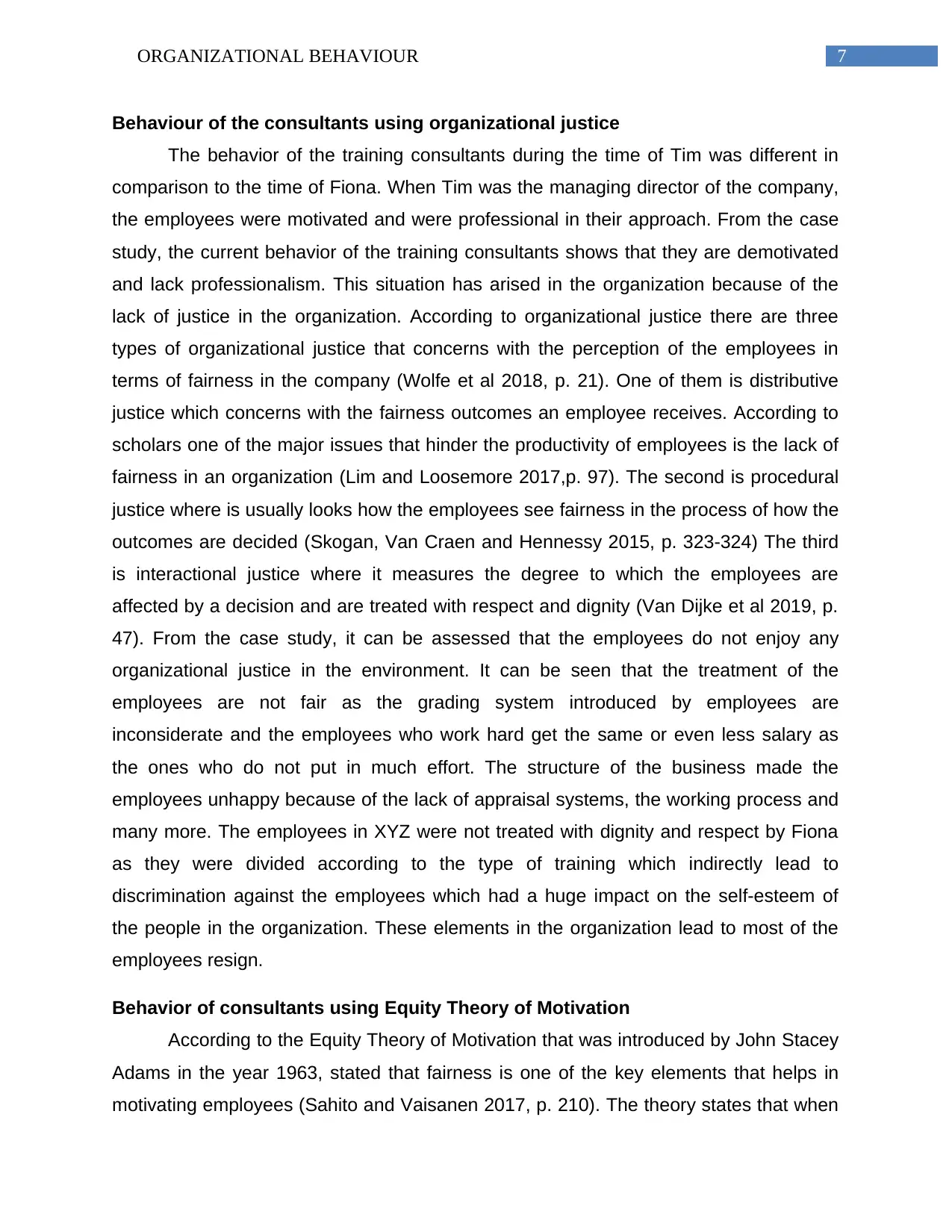
7ORGANIZATIONAL BEHAVIOUR
Behaviour of the consultants using organizational justice
The behavior of the training consultants during the time of Tim was different in
comparison to the time of Fiona. When Tim was the managing director of the company,
the employees were motivated and were professional in their approach. From the case
study, the current behavior of the training consultants shows that they are demotivated
and lack professionalism. This situation has arised in the organization because of the
lack of justice in the organization. According to organizational justice there are three
types of organizational justice that concerns with the perception of the employees in
terms of fairness in the company (Wolfe et al 2018, p. 21). One of them is distributive
justice which concerns with the fairness outcomes an employee receives. According to
scholars one of the major issues that hinder the productivity of employees is the lack of
fairness in an organization (Lim and Loosemore 2017,p. 97). The second is procedural
justice where is usually looks how the employees see fairness in the process of how the
outcomes are decided (Skogan, Van Craen and Hennessy 2015, p. 323-324) The third
is interactional justice where it measures the degree to which the employees are
affected by a decision and are treated with respect and dignity (Van Dijke et al 2019, p.
47). From the case study, it can be assessed that the employees do not enjoy any
organizational justice in the environment. It can be seen that the treatment of the
employees are not fair as the grading system introduced by employees are
inconsiderate and the employees who work hard get the same or even less salary as
the ones who do not put in much effort. The structure of the business made the
employees unhappy because of the lack of appraisal systems, the working process and
many more. The employees in XYZ were not treated with dignity and respect by Fiona
as they were divided according to the type of training which indirectly lead to
discrimination against the employees which had a huge impact on the self-esteem of
the people in the organization. These elements in the organization lead to most of the
employees resign.
Behavior of consultants using Equity Theory of Motivation
According to the Equity Theory of Motivation that was introduced by John Stacey
Adams in the year 1963, stated that fairness is one of the key elements that helps in
motivating employees (Sahito and Vaisanen 2017, p. 210). The theory states that when
Behaviour of the consultants using organizational justice
The behavior of the training consultants during the time of Tim was different in
comparison to the time of Fiona. When Tim was the managing director of the company,
the employees were motivated and were professional in their approach. From the case
study, the current behavior of the training consultants shows that they are demotivated
and lack professionalism. This situation has arised in the organization because of the
lack of justice in the organization. According to organizational justice there are three
types of organizational justice that concerns with the perception of the employees in
terms of fairness in the company (Wolfe et al 2018, p. 21). One of them is distributive
justice which concerns with the fairness outcomes an employee receives. According to
scholars one of the major issues that hinder the productivity of employees is the lack of
fairness in an organization (Lim and Loosemore 2017,p. 97). The second is procedural
justice where is usually looks how the employees see fairness in the process of how the
outcomes are decided (Skogan, Van Craen and Hennessy 2015, p. 323-324) The third
is interactional justice where it measures the degree to which the employees are
affected by a decision and are treated with respect and dignity (Van Dijke et al 2019, p.
47). From the case study, it can be assessed that the employees do not enjoy any
organizational justice in the environment. It can be seen that the treatment of the
employees are not fair as the grading system introduced by employees are
inconsiderate and the employees who work hard get the same or even less salary as
the ones who do not put in much effort. The structure of the business made the
employees unhappy because of the lack of appraisal systems, the working process and
many more. The employees in XYZ were not treated with dignity and respect by Fiona
as they were divided according to the type of training which indirectly lead to
discrimination against the employees which had a huge impact on the self-esteem of
the people in the organization. These elements in the organization lead to most of the
employees resign.
Behavior of consultants using Equity Theory of Motivation
According to the Equity Theory of Motivation that was introduced by John Stacey
Adams in the year 1963, stated that fairness is one of the key elements that helps in
motivating employees (Sahito and Vaisanen 2017, p. 210). The theory states that when
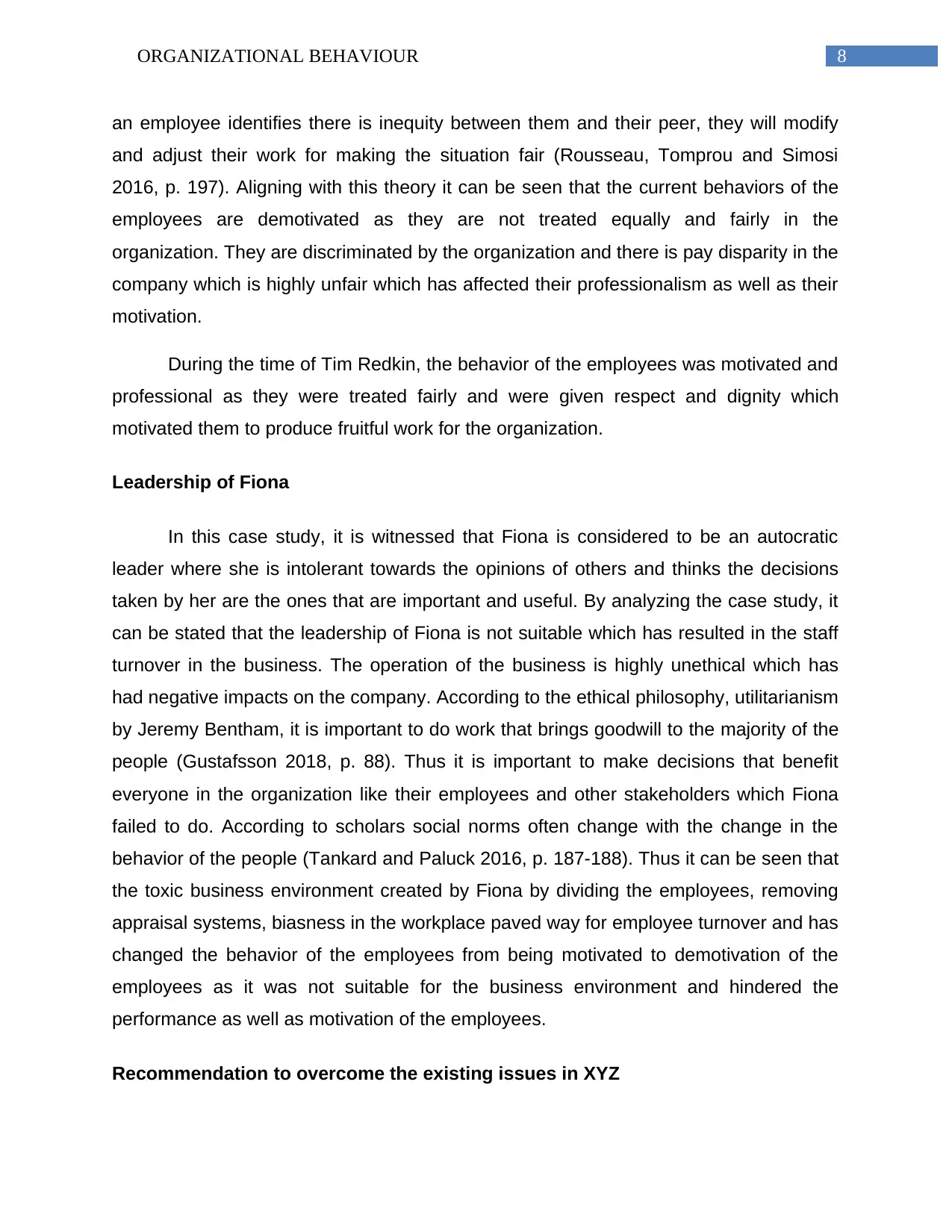
8ORGANIZATIONAL BEHAVIOUR
an employee identifies there is inequity between them and their peer, they will modify
and adjust their work for making the situation fair (Rousseau, Tomprou and Simosi
2016, p. 197). Aligning with this theory it can be seen that the current behaviors of the
employees are demotivated as they are not treated equally and fairly in the
organization. They are discriminated by the organization and there is pay disparity in the
company which is highly unfair which has affected their professionalism as well as their
motivation.
During the time of Tim Redkin, the behavior of the employees was motivated and
professional as they were treated fairly and were given respect and dignity which
motivated them to produce fruitful work for the organization.
Leadership of Fiona
In this case study, it is witnessed that Fiona is considered to be an autocratic
leader where she is intolerant towards the opinions of others and thinks the decisions
taken by her are the ones that are important and useful. By analyzing the case study, it
can be stated that the leadership of Fiona is not suitable which has resulted in the staff
turnover in the business. The operation of the business is highly unethical which has
had negative impacts on the company. According to the ethical philosophy, utilitarianism
by Jeremy Bentham, it is important to do work that brings goodwill to the majority of the
people (Gustafsson 2018, p. 88). Thus it is important to make decisions that benefit
everyone in the organization like their employees and other stakeholders which Fiona
failed to do. According to scholars social norms often change with the change in the
behavior of the people (Tankard and Paluck 2016, p. 187-188). Thus it can be seen that
the toxic business environment created by Fiona by dividing the employees, removing
appraisal systems, biasness in the workplace paved way for employee turnover and has
changed the behavior of the employees from being motivated to demotivation of the
employees as it was not suitable for the business environment and hindered the
performance as well as motivation of the employees.
Recommendation to overcome the existing issues in XYZ
an employee identifies there is inequity between them and their peer, they will modify
and adjust their work for making the situation fair (Rousseau, Tomprou and Simosi
2016, p. 197). Aligning with this theory it can be seen that the current behaviors of the
employees are demotivated as they are not treated equally and fairly in the
organization. They are discriminated by the organization and there is pay disparity in the
company which is highly unfair which has affected their professionalism as well as their
motivation.
During the time of Tim Redkin, the behavior of the employees was motivated and
professional as they were treated fairly and were given respect and dignity which
motivated them to produce fruitful work for the organization.
Leadership of Fiona
In this case study, it is witnessed that Fiona is considered to be an autocratic
leader where she is intolerant towards the opinions of others and thinks the decisions
taken by her are the ones that are important and useful. By analyzing the case study, it
can be stated that the leadership of Fiona is not suitable which has resulted in the staff
turnover in the business. The operation of the business is highly unethical which has
had negative impacts on the company. According to the ethical philosophy, utilitarianism
by Jeremy Bentham, it is important to do work that brings goodwill to the majority of the
people (Gustafsson 2018, p. 88). Thus it is important to make decisions that benefit
everyone in the organization like their employees and other stakeholders which Fiona
failed to do. According to scholars social norms often change with the change in the
behavior of the people (Tankard and Paluck 2016, p. 187-188). Thus it can be seen that
the toxic business environment created by Fiona by dividing the employees, removing
appraisal systems, biasness in the workplace paved way for employee turnover and has
changed the behavior of the employees from being motivated to demotivation of the
employees as it was not suitable for the business environment and hindered the
performance as well as motivation of the employees.
Recommendation to overcome the existing issues in XYZ
⊘ This is a preview!⊘
Do you want full access?
Subscribe today to unlock all pages.

Trusted by 1+ million students worldwide
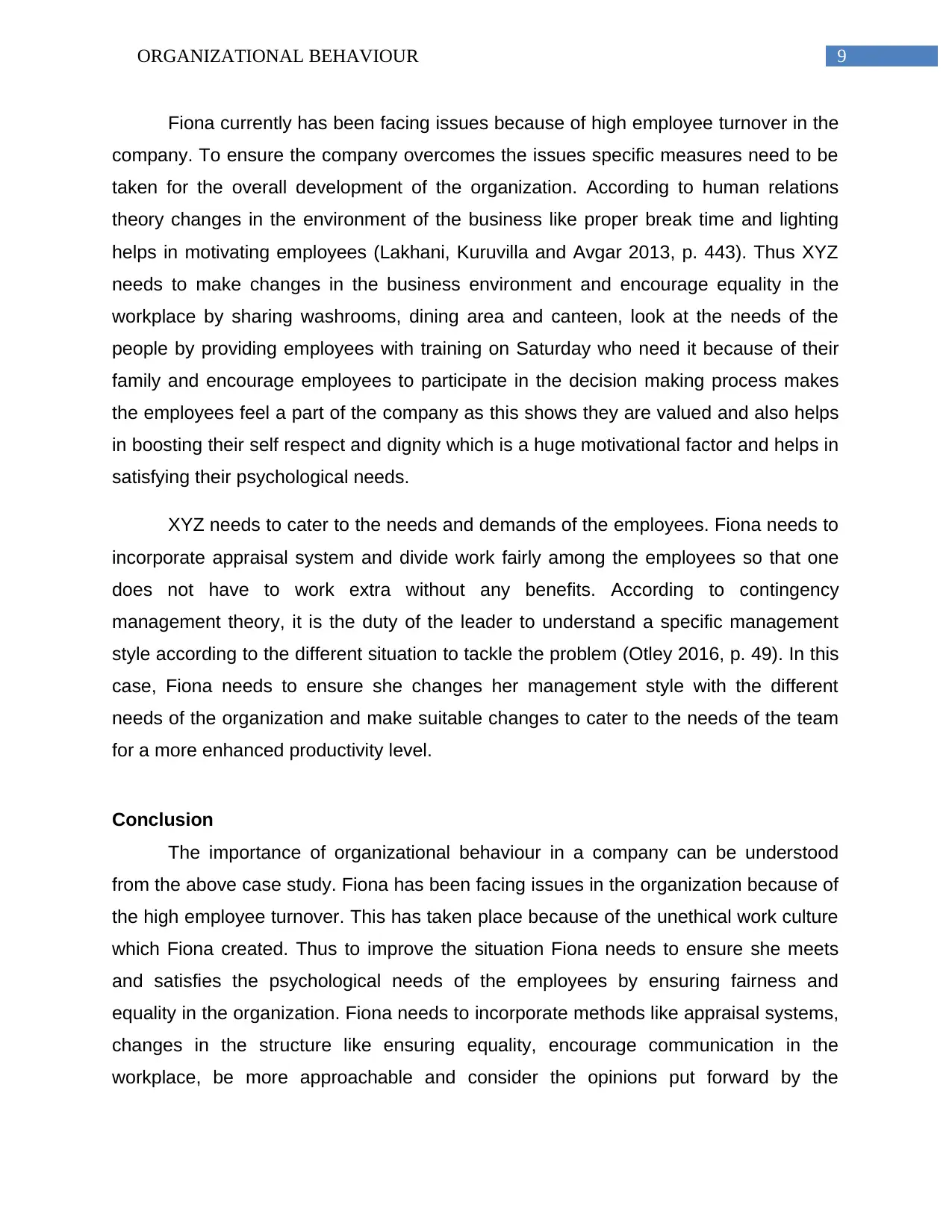
9ORGANIZATIONAL BEHAVIOUR
Fiona currently has been facing issues because of high employee turnover in the
company. To ensure the company overcomes the issues specific measures need to be
taken for the overall development of the organization. According to human relations
theory changes in the environment of the business like proper break time and lighting
helps in motivating employees (Lakhani, Kuruvilla and Avgar 2013, p. 443). Thus XYZ
needs to make changes in the business environment and encourage equality in the
workplace by sharing washrooms, dining area and canteen, look at the needs of the
people by providing employees with training on Saturday who need it because of their
family and encourage employees to participate in the decision making process makes
the employees feel a part of the company as this shows they are valued and also helps
in boosting their self respect and dignity which is a huge motivational factor and helps in
satisfying their psychological needs.
XYZ needs to cater to the needs and demands of the employees. Fiona needs to
incorporate appraisal system and divide work fairly among the employees so that one
does not have to work extra without any benefits. According to contingency
management theory, it is the duty of the leader to understand a specific management
style according to the different situation to tackle the problem (Otley 2016, p. 49). In this
case, Fiona needs to ensure she changes her management style with the different
needs of the organization and make suitable changes to cater to the needs of the team
for a more enhanced productivity level.
Conclusion
The importance of organizational behaviour in a company can be understood
from the above case study. Fiona has been facing issues in the organization because of
the high employee turnover. This has taken place because of the unethical work culture
which Fiona created. Thus to improve the situation Fiona needs to ensure she meets
and satisfies the psychological needs of the employees by ensuring fairness and
equality in the organization. Fiona needs to incorporate methods like appraisal systems,
changes in the structure like ensuring equality, encourage communication in the
workplace, be more approachable and consider the opinions put forward by the
Fiona currently has been facing issues because of high employee turnover in the
company. To ensure the company overcomes the issues specific measures need to be
taken for the overall development of the organization. According to human relations
theory changes in the environment of the business like proper break time and lighting
helps in motivating employees (Lakhani, Kuruvilla and Avgar 2013, p. 443). Thus XYZ
needs to make changes in the business environment and encourage equality in the
workplace by sharing washrooms, dining area and canteen, look at the needs of the
people by providing employees with training on Saturday who need it because of their
family and encourage employees to participate in the decision making process makes
the employees feel a part of the company as this shows they are valued and also helps
in boosting their self respect and dignity which is a huge motivational factor and helps in
satisfying their psychological needs.
XYZ needs to cater to the needs and demands of the employees. Fiona needs to
incorporate appraisal system and divide work fairly among the employees so that one
does not have to work extra without any benefits. According to contingency
management theory, it is the duty of the leader to understand a specific management
style according to the different situation to tackle the problem (Otley 2016, p. 49). In this
case, Fiona needs to ensure she changes her management style with the different
needs of the organization and make suitable changes to cater to the needs of the team
for a more enhanced productivity level.
Conclusion
The importance of organizational behaviour in a company can be understood
from the above case study. Fiona has been facing issues in the organization because of
the high employee turnover. This has taken place because of the unethical work culture
which Fiona created. Thus to improve the situation Fiona needs to ensure she meets
and satisfies the psychological needs of the employees by ensuring fairness and
equality in the organization. Fiona needs to incorporate methods like appraisal systems,
changes in the structure like ensuring equality, encourage communication in the
workplace, be more approachable and consider the opinions put forward by the
Paraphrase This Document
Need a fresh take? Get an instant paraphrase of this document with our AI Paraphraser
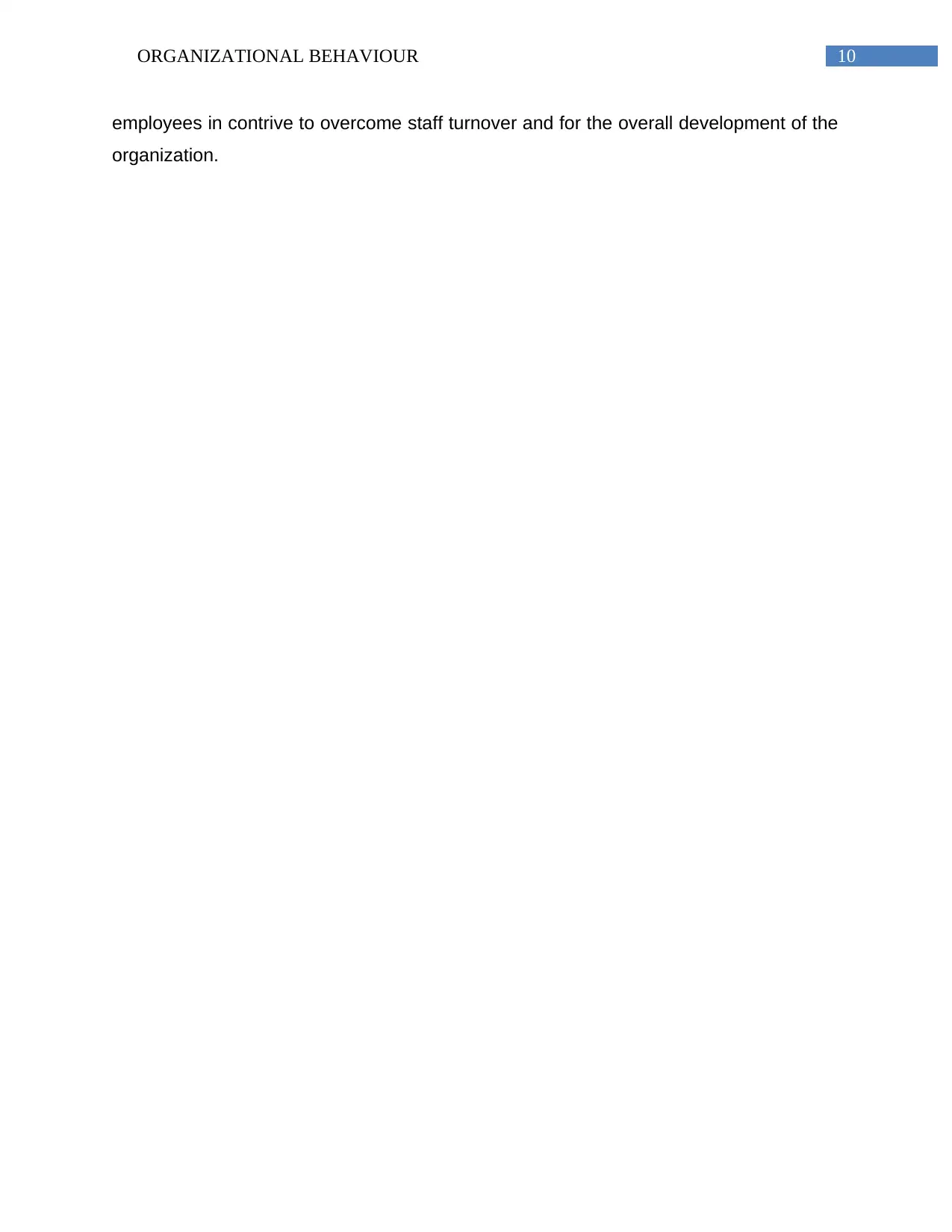
10ORGANIZATIONAL BEHAVIOUR
employees in contrive to overcome staff turnover and for the overall development of the
organization.
employees in contrive to overcome staff turnover and for the overall development of the
organization.
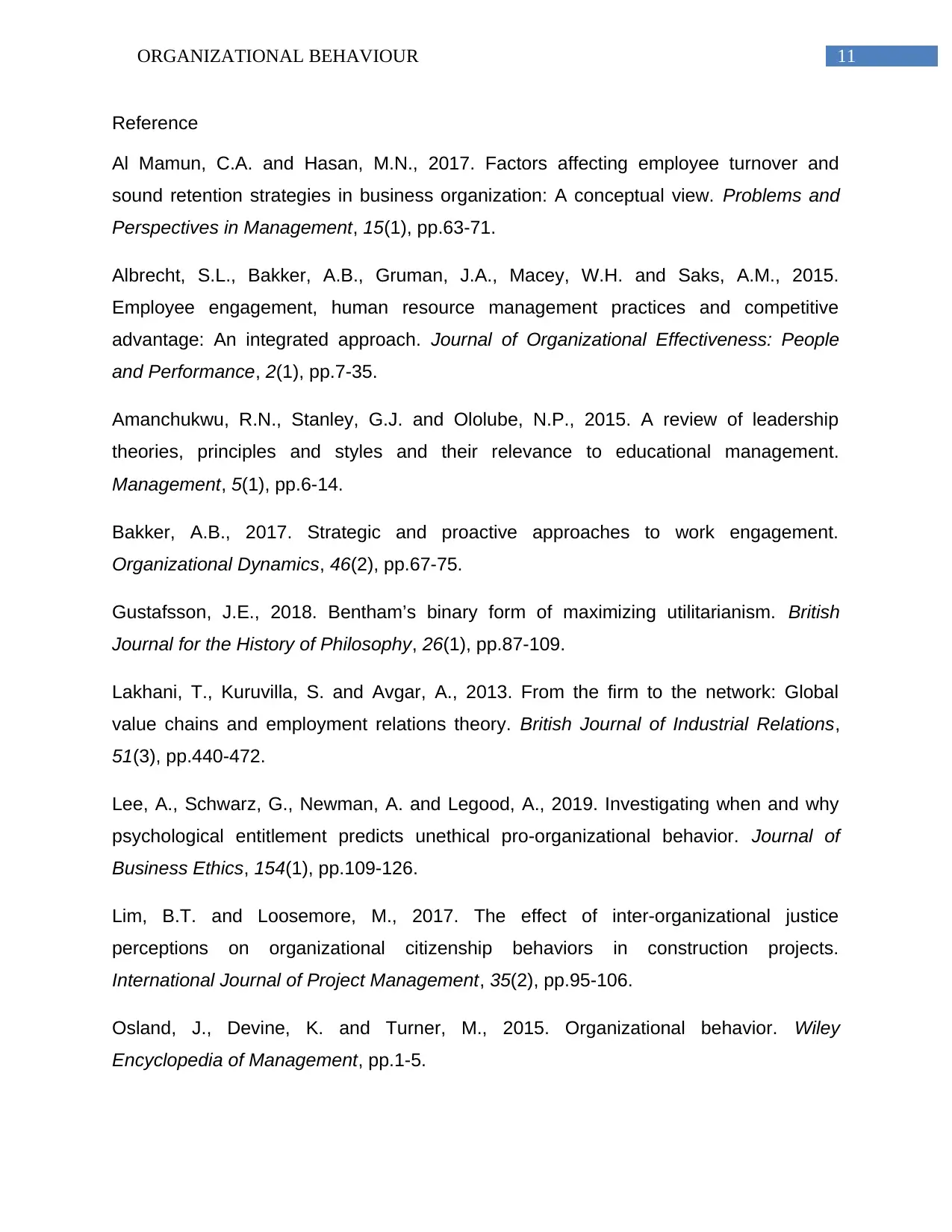
11ORGANIZATIONAL BEHAVIOUR
Reference
Al Mamun, C.A. and Hasan, M.N., 2017. Factors affecting employee turnover and
sound retention strategies in business organization: A conceptual view. Problems and
Perspectives in Management, 15(1), pp.63-71.
Albrecht, S.L., Bakker, A.B., Gruman, J.A., Macey, W.H. and Saks, A.M., 2015.
Employee engagement, human resource management practices and competitive
advantage: An integrated approach. Journal of Organizational Effectiveness: People
and Performance, 2(1), pp.7-35.
Amanchukwu, R.N., Stanley, G.J. and Ololube, N.P., 2015. A review of leadership
theories, principles and styles and their relevance to educational management.
Management, 5(1), pp.6-14.
Bakker, A.B., 2017. Strategic and proactive approaches to work engagement.
Organizational Dynamics, 46(2), pp.67-75.
Gustafsson, J.E., 2018. Bentham’s binary form of maximizing utilitarianism. British
Journal for the History of Philosophy, 26(1), pp.87-109.
Lakhani, T., Kuruvilla, S. and Avgar, A., 2013. From the firm to the network: Global
value chains and employment relations theory. British Journal of Industrial Relations,
51(3), pp.440-472.
Lee, A., Schwarz, G., Newman, A. and Legood, A., 2019. Investigating when and why
psychological entitlement predicts unethical pro-organizational behavior. Journal of
Business Ethics, 154(1), pp.109-126.
Lim, B.T. and Loosemore, M., 2017. The effect of inter-organizational justice
perceptions on organizational citizenship behaviors in construction projects.
International Journal of Project Management, 35(2), pp.95-106.
Osland, J., Devine, K. and Turner, M., 2015. Organizational behavior. Wiley
Encyclopedia of Management, pp.1-5.
Reference
Al Mamun, C.A. and Hasan, M.N., 2017. Factors affecting employee turnover and
sound retention strategies in business organization: A conceptual view. Problems and
Perspectives in Management, 15(1), pp.63-71.
Albrecht, S.L., Bakker, A.B., Gruman, J.A., Macey, W.H. and Saks, A.M., 2015.
Employee engagement, human resource management practices and competitive
advantage: An integrated approach. Journal of Organizational Effectiveness: People
and Performance, 2(1), pp.7-35.
Amanchukwu, R.N., Stanley, G.J. and Ololube, N.P., 2015. A review of leadership
theories, principles and styles and their relevance to educational management.
Management, 5(1), pp.6-14.
Bakker, A.B., 2017. Strategic and proactive approaches to work engagement.
Organizational Dynamics, 46(2), pp.67-75.
Gustafsson, J.E., 2018. Bentham’s binary form of maximizing utilitarianism. British
Journal for the History of Philosophy, 26(1), pp.87-109.
Lakhani, T., Kuruvilla, S. and Avgar, A., 2013. From the firm to the network: Global
value chains and employment relations theory. British Journal of Industrial Relations,
51(3), pp.440-472.
Lee, A., Schwarz, G., Newman, A. and Legood, A., 2019. Investigating when and why
psychological entitlement predicts unethical pro-organizational behavior. Journal of
Business Ethics, 154(1), pp.109-126.
Lim, B.T. and Loosemore, M., 2017. The effect of inter-organizational justice
perceptions on organizational citizenship behaviors in construction projects.
International Journal of Project Management, 35(2), pp.95-106.
Osland, J., Devine, K. and Turner, M., 2015. Organizational behavior. Wiley
Encyclopedia of Management, pp.1-5.
⊘ This is a preview!⊘
Do you want full access?
Subscribe today to unlock all pages.

Trusted by 1+ million students worldwide
1 out of 13
Related Documents
Your All-in-One AI-Powered Toolkit for Academic Success.
+13062052269
info@desklib.com
Available 24*7 on WhatsApp / Email
![[object Object]](/_next/static/media/star-bottom.7253800d.svg)
Unlock your academic potential
Copyright © 2020–2025 A2Z Services. All Rights Reserved. Developed and managed by ZUCOL.





